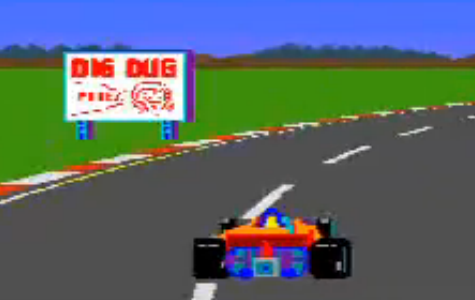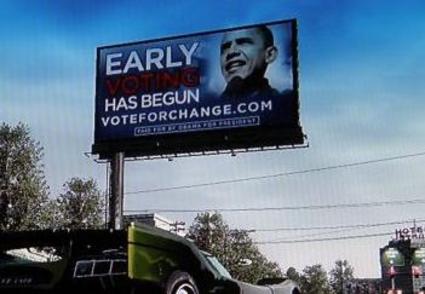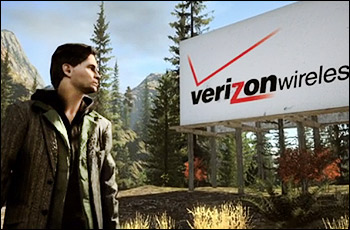Where It Came From
It should be noted that sticking brand names in video games is not a practise invented in recent years. It looks like the earliest instance of a brand name appearing in a game was in the 1973 title Lunar Lander, later versions of which included a McDonald’s restaurant that players could find. However, the first use of in-game advertisement specifically appears to have been when 1978’s fantasy text adventure game Adventureland featured an advert for the developer’s upcoming game, Pirate Adventure. 1982’s Pole Position is also remembered as a very early example of in-game advertising and although not the first, it is certainly one of the most notable.

While the argument has been made that video games and advertising are accomplices which date back a long while, it seems in the times of yore the games industry was far more concerned with advertising through advergames like Pepsi Invaders and Yo! Noid, while now the industry has its attention more firmly set on mainstream video games playing host to the adverts of big-name companies. This only makes sense, as the original child gamers have grown up and become more discerning in their tastes, and information on what games are good and what games aren’t exists in much greater amounts, with much greater accessibility.
It would be arguably impossible to get people to pay anything near full-price for an advergame these days and even when given away free they’re usually seen as little more than a joke by gaming audiences, but in-game ads or no in-game ads, people are going to buy up great numbers of games from established high budget franchises and they’re going to pay a lot of attention to the content within. Most advergames may have been horrifically bad but at least they kept advertisement somewhat separate from mainstream video games, as product placement bleeds into genuinely high quality games, advertisements in our medium are becoming less and less avoidable.
Laying Down the Issue
I’ll admit it, I’m probably more sensitive to in-game advertising than most, but I just don’t agree with many of the justifications given for in-game adverts these days. The usual defence of in-game advertising is that introducing elements from the real world into a game world can improve the realism of the game or at very least alter the experience for the worse very little, providing that products and adverts appear in the game in the same vague ways you’d see them appear in real-life. We all know that practises like disrupting gameplay to present a video advertisement are intrusive and annoying, but what’s wrong with neon signs advertising deodorant in Splinter Cell: Conviction? Or posters for men’s magazines appearing in the shopping centre of Dead Rising 2? It all mixes into the experience well and provides the people making games with more cash, right? The problem is this view is built on a false notion of how realism in games actually works.

As I stated in a blog I posted a few weeks back, immersing the player in an experience and giving them a world which feels believable and natural (at very least for the duration of their play time) has little to do with the game mirroring the real world and just about everything to do with the game presenting a consistent and high quality experience. Let me present two examples of brand name advertising, one that I thought worked in the game’s favour and one I thought detracted from the game experience. Anyone who has played the Rock Band games has undoubtedly noticed the brand names on the instruments in the game, perhaps most notably that of Fender who even had the guitar controller modelled around their famous Stratocaster guitar. This I like. In Burnout Paradise there are a number of billboards around the game which in the UK version of the game usually bare a Burger King logo and a large real-world picture of a burger. This I don’t like.
Focus
The overall experience you have with a video game is not just defined by the kind of world it’s presenting (medieval fantasy, an approximation of the real-world, futuristic space ship) but also by where the focus of the game lays. The focus of the Rock Band games is on playing instruments and acting as though you’re in a band, so when the game does its advertising through featuring real world instruments it mixes into the experience smoothly because focus is not shifted away from the normal experience you’d be having. The same is also true of any racing or driving game that uses real world cars or any sports game which includes real world players and teams.
The focus of Burnout Paradise is of course on driving like a crazy maniac in a world specifically designed for you to do so, under a set of delightfully impossible physics. This has little to do with burger outlets, so when you’re drifting around a canyon road at break-neck speed and the game shifts your focus briefly from “You’re driving this car like a fucking madman” to “Hey, wanna grab a flame-grilled whopper right now?” it feels out of place. After being jarred out of the experience in this way we usually recognise that disruptive aspect of the world for what it is, an advertisement, we register it as a very precise component of the real world, leaving it as an irksome reminder that the game world isn’t the real world. We may even be reminded that the advertisement was simply designed and placed there by a team of game developers, further ruining the illusion. For me personally knowing it’s an advertisement, an attempt to make money off of my fun, gives it an almost dirty cheapness.
Yet More Problems

The more recognisable the brand, the more it stands out as a reminder of the real world and potentially ruins the experience, but like many other adverts in games, the billboards in Burnout Paradise carry a few more problems with the way they’re used. Firstly, at very least one of the billboards in that game (it’s on the canyon road I mentioned) is strategically placed so you can’t help but look at it, the very way it’s integrated into the game does not seem to be done so in an effort to blend in with the world, but to be deliberately invasive to your experience to the point where even if it was a billboard advertising a fictional product it would still seem a little odd that it’s presented in that way. People who seem to give the thumbs up to billboards, banners, screens, etc. in games being used for advertisements don’t usually consider that there’s a large gulf between developers using these advertisement methods in a subtle manner and them jamming them down your throat.
Another problem with Paradise’s billboards is that they, like the advertisements in a number of other games, insist on advertising their product through real world photographs. Having this contrast of real world imagery against the computer-generated imagery of the game, again, serves as an unwelcome reminder that the game world isn’t real.
Lastly, the fact that Burger King and perhaps a handful of other names are the only brands in the game doesn’t help create an environment that seems realistic. This might sound odd, am I really saying more brand names would be better for the game? But let me put it this way; a game with no real world brand names is consistent, a game where everything is branded much like it is in the real world would be consistent, a game where the world has no real world brand names except for a small number is remarkably inconsistent. If this is a world where real brands exist, where are all the other billboard advertisements?
Duder, It’s Over

I think you see my point. This is a somewhat speculative statement but I can’t help but wonder whether people who approve of the kind of in-game advertising I find frustrating and off-putting do so not because they really feel it’s that realistic, but because they either currently like the novelty of recognising something from real-life in a video game, think it looks good in theory, can’t find a justification for not liking it, or some combination of these elements. Of course the real problem is that there’s probably going to be nothing but encouragement for developers and publishers to keep using product placement in games and if the ESA have any clear idea about the situation we’re going to see a lot more of it very soon. I have to confess, as frustrating as I might find it when it’s done poorly, developers and publishers would have to go to some serious lengths to use advertising in a way that would stop me from buying a game I otherwise really wanted, and I’m sure the same applies to many other people.
As it is in-game advertising could be a lot worse right now and I for one am thankful that it hasn’t got too over-the-top yet, even if I would like to see a crack-down on badly done advertisements in games. For me the real tragedy of the situation is that most of us, on some level, use video games as a form of escapism from the real world, so seeing the people funding games trying to ensure that more of the real world bleeds into video games in a potentially negative way is a little saddening, but I guess it’s just something we’ll have to learn to live with. Thank you for reading.
-Gamer_152


Log in to comment